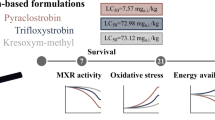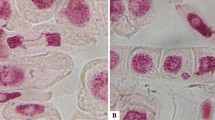Abstract
The great expansion in recent years in the use of plant biostimulants has underestimated the possibility of producing environmental risks. The objective of this study was to evaluate the cytotoxicity, genotoxicity, and toxicity of three different biostimulants (A, B, and C) produced and widely marketed in Brazil and exported to other countries on both plant and animal indicator organisms. In Allium cepa (non-target species of these plant biostimulants), the concentrations evaluated for the products A and B (0.0625 at 0.500 mL/L), and C (0.0625 at 0.500 g/L) induced inhibition of cell proliferation on meristems, in at least one time of analysis, characterizing them as cytotoxic. The three biostimulants promoted an expressive number of prophases in detriment to the other phases of cell division. In the test with Artemia salina, different concentrations of the biostimulants were tested, ranging from 1000 to 1.95 ppm, and the toxic potential was evaluated through the LC50. The three products showed high toxicity (LC50 < 100 ppm) against microcrustaceans. The results obtained in the present study suggest that the evaluated biostimulants may be toxic to non-target plants and toxic to organisms in water bodies influenced by leaching from soil with the presence of these substances.

Similar content being viewed by others
References
Bertan AS, Baumbach F, Tonial IB, Pokrywiecki TS, Düsman E (2019). Evaluation of the phytoremediation potential of Allium cepa L. in the treatment of raw sewage. Brazilian Journal of Biology (ahead of print).
Calfee, R. D., & Little, E. E. (2017). Toxicity of cadmium, copper, and zinc to the threatened Chiricahua leopard frog (Lithobates [Rana] chiricahuensis). Bulletin of Environmental Contamination and Toxicology, 99, 679–683.
Chiaiese, P., Corrado, G., Colla, G., Kyriacou, M. C., & Rouphael, Y. (2018). Renewable sources of plant biostimulation: microalgae as a sustainable means to improve crop performance. Frontiers in Plant Science, 9, 1782.
Colla, G., Hoagland, L., Ruzzi, M., Cardarelli, M., Bonini, P., Canaguier, R., & Rouphael, Y. (2017). Biostimulant action of protein hydrolysates: unraveling their effects on plant physiology and microbiome. Frontiers in Plant Science, 8, 2202.
Ertani, A., Francioso, O., Tinti, A., Schiavon, M., Pizzeghello, D., & Nardi, S. (2018). Evaluation of seaweed extracts from Laminaria and Ascophyllum nodosum spp. as biostimulants in Zea mays L. using a combination of chemical, biochemical and morphological approaches. Frontiers in Plant Science, 9, 428.
Furness RW (2017). Heavy metals in the marine environment: CRC press
Ghosh, M., Sinha, S., Jothiramajayam, M., Jana, A., Nag, A., & Mukherjee, A. (2016). Cyto-genotoxicity and oxidative stress induced by zinc oxide nanoparticle in human lymphocyte cells in vitro and Swiss albino male mice in vivo. Food Chemical and Toxicology, 97, 286–296.
Guedes, C. M., Santos, F. K. S., Silva, T., Soares, A. P., Silva, M. V. S. L., Silva, M. E. S., et al. (2018). Cytotoxic and genotoxic potential of Ginkgo biloba L., in industrialized and without-additive forms. Bioscience Journal, 34(4), 1017–1024.
Guerra M, Souza MJ (2002). How to observe the chromosomes: a guide to techniques in plant, animal and human cytogenetics. Ribeirão Preto: FUNPEC. (in Portuguese).
Herrero, O., Martín, J. P., Freire, O. F., López, L. C., Peropadre, A., & Hazen, M. J. (2012). Toxicological evaluation of three contaminant of emerging concern by use of Allium cepa test. Mutation Research, 743(1–2), 24–34.
Kumari, M., Khan, S. S., Pakrashi, S., Mukherjee, A., & Chandrasekaran, N. (2011). Cytogenetic and genotoxic effects of zinc oxide nanoparticles on root cells of Allium cepa. Journal of Hazardous Material, 190(1–3), 613–621.
Matos, L. A., Cunha, A. C., Sousa, A. A., Maranhão, J. P., Santos, N. R., Gonçalves, M., & Alencar, M. V. (2017). The influence of heavy metals on toxicogenetic damage in a Brazilian tropical river. Chemosphere, 185, 852–859.
Meyer, B. N., Ferrign, R. N., Putnam, J. E., Jacobson, L. B., Nicholas, D. E., & Mclaughlin, J. L. (1982). Brine shrimp: a convenient general bioassay for active plant constituents. Planta Medica, 45, 31–34.
O'Neill, A., Gupta, B. S., & Phillips, D. H. (2014). Distribution of arsenic and risk assessment of activities on a golf course fertilised with arsenic-containing Ascophyllum nodosum seaweed. Science of the Total Environment, 482, 252–259.
Panfili, I., Bartucca, M. L., & Del Buono, D. (2019). The treatment of duckweed with a plant biostimulant or a safener improves the plant capacity to clean water polluted by terbuthylazine. Science of the Total Environment, 646, 832–840.
Paredes, P.F.M., Vasconcelos, F.R., Paim, R.T.T., Marques, M.M.M., Morais, S.M., Lira, S.M., et al. (2016). Screening of bioactivities and toxicity of Cnidoscolus quercifolius Pohl. Evidence-Based Complementary and Alternative Medicine (Print), 2016.
Rawi, S. M., Seif, A. L., & Nassr, F. M. (2015). Zinc sulphate and vitamin E alleviate reproductive toxicity caused by aluminium sulphate in male albino rats. Toxicology and Industrial Health, 31, 221–234.
Rocha, R. B. R., Peron, A. P. P., Santos, F. K. S., Marques, M. M. M. M., Sousa, M. E. S. S., Oliveira, V. A. D. O., et al. (2018). Toxic, cytotoxic and genotoxic potential of synthetic food flavoring. Acta Toxicológica Argentina, 26, 60–70.
Rosa, C. S., Veras, K. S., Silva, P. R., Lopes-Neto, J. J., Cardoso, H. L. M., Alves, L. P. L., et al. (2016). Chemical composition and toxicity against Aedes aegypti L. and Artemia salina Leach from the essential oil of the leaves of Myrciasylvatica (G. Mey.) DC. Revista Brasileira de Plantas Medicinais, 18, 19–26.
Rouphael, Y., Spíchal, L., Panzarová, K., Casa, R., & Colla, G. (2018). High-throughput plant phenoty** for develo** novel biostimulants: from lab to field or from field to lab? Frontiers in Plant Science, 9, 1197.
Simplício, N., Muniz, D., Rocha, F., Martins, D., Dias, Z., Farias, B., et al. (2017). Comparative analysis between ecotoxicity of nitrogen-, phosphorus-, and potassium-based fertilizers and their active ingredients. Toxics, 5(1), 15–20.
Tabrez, S., Shakil, S., Urooj, M., Damanhouri, G. A., Abuzenadah, A. M., & Ahmad, M. (2011). Genotoxicity testing and biomarker studies on surface waters: an overview of the techniques and their efficacies. Journal of Environmental Science and Health, Part C, 9(2), 250–275.
Taranath, T. C., Patil, B. N., Santosh, T. U., & Sharath, B. S. (2015). Cytotoxicity of zinc nanoparticles fabricated by Justicia adhatoda L. on root tips of Allium cepa L.—a model approach. Environmental Science and Pollution Research, 22, 8611–8617.
Wilson, H. T., Amirkhani, M., & Taylor, A. G. (2018). Evaluation of gelatin as a biostimulant seed treatment to improve plant performance. Frontiers in Plant Science, 9, 1006.
Zilifdar, F., Alper-Hayta, S., Yilmaz, S., Kaplan-Özen, Ç., Foto, E., Aydoğan, Z., et al. (2014). Genotoxic potentials and eukaryotic DNA topoisomerase I inhibitory effects of some benzoxazine derivatives. Medical Chemical Research, 23, 480–486.
Author information
Authors and Affiliations
Corresponding author
Additional information
Publisher’s Note
Springer Nature remains neutral with regard to jurisdictional claims in published maps and institutional affiliations.
Rights and permissions
About this article
Cite this article
Silva, T.S., Silva, A.P.S., de Almeida Santos, A. et al. Cytotoxicity, Genotoxicity, and Toxicity of Plant Biostimulants Produced in Brazil: Subsidies for Determining Environmental Risk to Non-Target Species. Water Air Soil Pollut 231, 233 (2020). https://doi.org/10.1007/s11270-020-04614-x
Received:
Accepted:
Published:
DOI: https://doi.org/10.1007/s11270-020-04614-x




